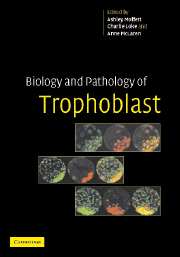Book contents
- Frontmatter
- Contents
- List of contributors
- List of participants
- Preface
- Chair's introduction
- 1 Trophoblast cell fate specification
- 2 Stem cells: pluripotency and extraembryonic differentiation in the mouse
- 3 Epigenetic regulation of trophoblast development
- 4 Regulation of X-chromosome inactivation in relation to lineage allocation in early mouse embryogenesis
- General discussion I
- General discussion II
- 9 Molecular signalling in embryo–uterine interactions during implantation
- 10 Trophoblast and pre-eclampsia
- 11 Trophoblast and uterine mucosal leukocytes
- 12 Immunology of trophoblast: a reappraisal
- Final general discussion
- Index
- Plate section
- References
9 - Molecular signalling in embryo–uterine interactions during implantation
from General discussion II
Published online by Cambridge University Press: 07 August 2009
- Frontmatter
- Contents
- List of contributors
- List of participants
- Preface
- Chair's introduction
- 1 Trophoblast cell fate specification
- 2 Stem cells: pluripotency and extraembryonic differentiation in the mouse
- 3 Epigenetic regulation of trophoblast development
- 4 Regulation of X-chromosome inactivation in relation to lineage allocation in early mouse embryogenesis
- General discussion I
- General discussion II
- 9 Molecular signalling in embryo–uterine interactions during implantation
- 10 Trophoblast and pre-eclampsia
- 11 Trophoblast and uterine mucosal leukocytes
- 12 Immunology of trophoblast: a reappraisal
- Final general discussion
- Index
- Plate section
- References
Summary
The process of implantation involves complex interactions between embryonic and uterine cells. The major events of this process include synchronised development of the preimplantation embryo into an implantation-competent blastocyst and establishment of the uterus to the receptive state (Psychoyos 1973a), escape of the semiallogenic embryo from the maternal immunological response (Beer & Billingham 1978), increased capillary permeability and blood flow at the site of blastocyst apposition (Psychoyos 1973a), post-attachment localised stromal decidualisation (De Feo 1967, Psychoyos 1973a) and controlled uterine invasion by embryonic trophoblasts (Kirby & Cowell 1968). Uterine receptivity is defined as a restricted period when the uterus supports blastocyst attachment (Psychoyos 1973b). Therefore, successful implantation of an embryo is contingent upon the initiation of these critical events during this ‘window’ of receptivity, and failure to initiate these events results in early pregnancy failure.
Preimplantation embryo development, which culminates in the formation of a blastocyst, requires the activation of the embryonic genome. Upon activation of the embryonic genome, the embryo grows rapidly to form a blastocyst. At the blastocyst stage, embryos mature and escape from their zona pellucidae to gain implantation competency. The differentiated and expanded blastocyst is composed of three cell types: the outer polarised epithelial trophectoderm, the primitive endoderm and the pluripotent inner cell mass (ICM). The ICM provides the future cell lineages for the embryo proper (McLaren 1990, Hogan et al. 1994), while the trophectoderm, the very first epithelial cell type in the developmental process, makes the initial physical and physiological connection with the uterine luminal epithelium.
- Type
- Chapter
- Information
- Biology and Pathology of Trophoblast , pp. 173 - 193Publisher: Cambridge University PressPrint publication year: 2006



